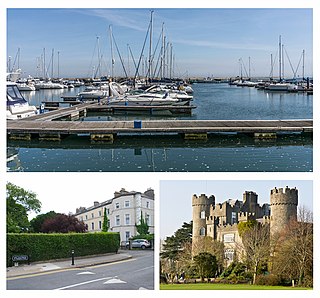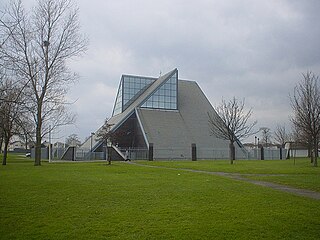
The Northside in an informal but commonly used term to describe the part of the city of Dublin that lies to the north of the River Liffey, and extending into part of North County Dublin. The part outside the city is within the county of Fingal, a local government area established in 1994. While it is sometimes regarded as less wealthy than the city's Southside, the Northside was originally the home of the city's upper classes and the more privileged of the two. Today, some of the wealthiest areas in Ireland, such as Malahide, Howth, Clontarf, and Castleknock, lie north of the river.

Malahide is an affluent coastal settlement in Fingal, County Dublin, Ireland, situated 14 kilometres north of Dublin city. It has a village centre surrounded by suburban housing estates, with a population of 18,608 as per the 2022 census.

Coolock is a large suburban area, centred on a village, on Dublin city's Northside in Ireland. Coolock is crossed by the Santry River, a prominent feature in the middle of the district, with a linear park and ponds. The Coolock suburban area encompasses parts of three Dublin postal districts: Dublin 5, Dublin 13 and Dublin 17.

Raheny is a northern suburb of Dublin, Ireland, halfway from the city centre to Howth. It is centred on a historic settlement, first documented in 570 AD. The district shares Dublin's two largest municipal parks, Saint Anne's Park and Bull Island with its 4.5 km beach, with neighbouring Clontarf, and is crossed by several small watercourses.

Baldoyle is a coastal suburb of Dublin's northside. It is located in the southeastern part of the jurisdiction of Fingal, Ireland, developed from a former fishing village.

Santry is a suburb on the northside of Dublin, Ireland, bordering Coolock, Glasnevin, Kilmore and Ballymun. It straddles the boundary of Dublin City Council and Fingal County Council jurisdictions.

Donaghmede is a mixed socio-economic residential suburb on the northern side of Dublin, Ireland, formed from parts of Baldoyle, Coolock and Raheny in the 1970s. It contains a mid-size shopping centre and a ruined chapel, and lies within the jurisdiction of Dublin City Council.

The River Tolka, also once spelled Tolga, is one of Dublin's three main rivers, flowing from County Meath to Fingal within the old County Dublin, and through the north of Dublin city, Ireland. By flow of water, the Tolka is the second largest river in Dublin, following the Liffey, but runs more slowly than the Dodder.

The River Camac is one of the larger rivers in Dublin and was one of four tributaries of the Liffey critical to the early development of the city.
Balgriffin is a suburb of Dublin, Ireland. It lies on the administrative boundary between Dublin City and the county of Fingal in the traditional County Dublin.

The Naniken River is a minor river on the north side of Dublin city, Ireland, one of more than forty watercourses monitored by Dublin City Council. It is culverted for its upper course, visible in St Anne's Park for its entire lower course, and causes flooding somewhere along its line most years. The river flows entirely within the jurisdiction of Dublin City Council.
Harmonstown is a small suburban locality of Dublin, Ireland, located on its Northside. It straddles the boundary between modern-day Artane and Raheny. It has a population of 5,566 inhabitants as of 2016
The Parish of Raheny is the modern successor in the Roman Catholic Church to an early (1152) parish, in Raheny, a district of Dublin, Ireland, reputed to be a site of Christian settlement back to at least 570 A.D. Today's parish, within the Howth Deanery of the Roman Catholic Archdiocese of Dublin, comprises Raheny village and the central portion of the district, parts of which are also served by the parishes of Killester, Grange Park and Kilbarrack-Foxfield. The parish has a membership of around 10,000 Catholics. Similarly centred, and covering a greater land area but a much smaller membership, is the Church of Ireland parish of the same name.

The R104 road is a regional road in north Dublin, Ireland. The road passes through Finglas, Santry, and Coolock, along the northern edge of Raheny and finishes at the coast in Kilbarrack.
Coolock is one of the baronies of Ireland. It was constituted as part of the old county of Dublin. Today, it covers much of the northern parts of the city of Dublin and the south-eastern part of the modern county of Fingal. At the heart of the barony is the civil parish of the same name - Coolock - which is one of twenty civil parishes in the barony.

The Broadmeadow River or Broad Meadow Water, is a river of County Meath and northern County Dublin, about 25 kilometres (16 mi) long. It opens into a wide estuary between Swords and Malahide, and reaches the open sea several kilometres downstream, north of Malahide village. One of the larger watercourses by volume in County Dublin, the Broadmeadow is a salmonid river, with several species of fish, including brown trout. It has many small, and a few larger, tributaries, notably the Ward River. It is under the responsibility of Meath County Council and Fingal County Council, as well as oversight of the Environmental Protection Agency.
The Ward River, sometimes historically the Swords River, is a watercourse of County Meath and northern County Dublin. About 18 kilometres (11 mi) long; it runs through the town of Swords and then flows into the Broadmeadow River. The Ward is a salmonid river, with several species of fish, including brown trout. It has several small tributaries. The river is in the jurisdictions of Meath and Fingal County Councils, as well as within the oversight of the Environmental Protection Agency.
The Ballyboghil River or Ballyboughal Water is a river in Fingal, in the traditional County Dublin, about 18 kilometres (11 mi) long, reaching the sea by way of the 4.5 kilometres (2.8 mi)-long estuary. One of the larger watercourses by volume in the north County Dublin, the Ballyboghil is a salmonid river, with several species of fish, including brown trout. It has many small tributaries, and one larger tributary system. It is under the responsibility of Fingal County Council, and the oversight of the Environmental Protection Agency.
The Mayne River, is a small watercourse of northern County Dublin. It forms from the merger of the Cuckoo and Turnapin Streams, which rise near Dublin Airport and help drain the airport campus. The river is in the jurisdiction of Fingal County Council and within the oversight of the Environmental Protection Agency.
















